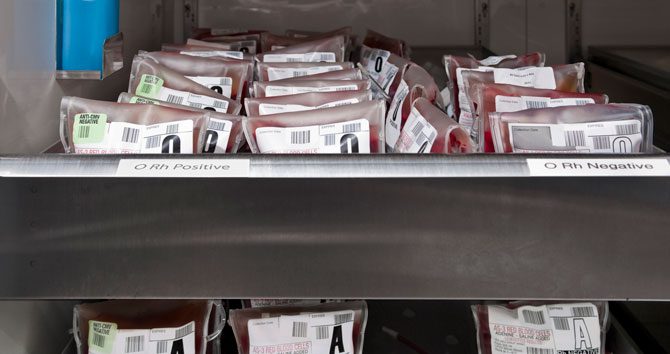In this article, we will highlight three ways your label supplier can help you reduce your overall blood labeling costs, while maintaining the accuracy and integrity of donations.
1. Redesign your DIN set
The single most significant cost component to a Donation Identification Number Label (DIN) set is its physical size. As you would expect, smaller sets typically cost less than larger sets due to decreased use of materials.
Be sure to take your time reviewing your current set; it’s not uncommon for blood banks to stick with the same design, size, and structure for years on end even though collection strategies may have evolved. Many blood banks last updated their DIN sets when ISBT 128 was implemented—that was over a decade ago!
Though it may seem cost effective to re-use the same design, it’s a good idea to continuously look for areas of improvement. A common design flaw that leads to additional costs in DIN sets is excess width. Consider ways your barcodes can be aligned to minimize width to avoid unnecessary material costs.
Next, you should meet with your internal stakeholders to see if there are labels in the set that are consistently going unused or are being disposed of. If your sets are regularly under-utilized, you should consider reducing the size of your set.
In cases when additional DIN labels are needed you can opt to use a DIN replicator. A DIN replicator is a simple scan-one-print-one device designed specifically to produce another label of the same set, on-demand and only when you need it.
Tube labels should always come from your pre-printed set because of the fixed scanning environment in your automated lab analyzers, but labels destined for use on documents, tie tags, or other blood containers can easily and accurately be produced on-demand with a DIN replicator.
2. Explore alternative materials
Similar to the design of your DIN set, it’s likely you’ve been using the same materials for years—after all, why change what works?
While your current system might do the job, it may be worth taking a step back and reviewing your options. A lot of new materials and constructions have been developed in recent years—some of which may be just as effective and lower in cost than your current solution.
It is important with any product that you do your research. This is especially the case in environments like blood banks, as you will be processing many blood samples and need to ensure you are making economic decisions for your business while maintaining quality assurance.
DIN label sets are typically double adhesive, which means there are two layers of adhesive and two release liners. Though double adhesive DIN sets are incredibly useful, the increased number of materials increases the areas of variable price.
Take some time to evaluate the materials involved in your DIN label sets and how they align with your budget and your processes. If you find there are lower cost material alternatives investigate whether or not they will stand up to the processes your samples will endure from phlebotomy to distribution.
Though lower cost materials can lead to savings, they can also lead to loss if they don’t align with your practices. Always take time to test and research your label’s compatibility with your processes prior to committing to a low cost strategy.
Your label supplier should also be knowledgeable of the best material options for your purposes through past industry experience and will serve as a useful information source.
3. Consider a multi-year agreement
Many label suppliers offer multiyear agreements which can be a great way to help you control the costs of your DIN sets and related materials. Multiyear agreements can provide your facility with a sense of security through consistency in source and supply, as well as price protection over an extended period of time.
When looking for a supplier to provide a multiyear agreement it’s best to find one that will cover a variety of your needs. Look for a supplier who will offer blank label stock, printers, printer ink/ribbon, DIN replicators and service agreements in addition to your DIN label sets.
Multi-year agreements can also lead to additional savings depending on which supplier you’re working with.
For example, Computype reduces the selling price of our DIN label sets when multi-year agreements are in place. When we know a customer has agreed to purchase their DIN labels from us for, say, three years, we can then negotiate favorable pricing from component suppliers—primarily the double-adhesives. Those savings are then passed on to you.
Suppliers strive to make your life easier, so many offer packages like this to ensure you have a guaranteed, cost-efficient solution for the future. This checks off a big box and allows you to focus on your business and important processes.
Reducing costs is always a goal in any business. In such a crucial industry, it’s important you prioritize the economic state of your company and the supplier you choose to do business with.
To learn more about reducing costs in your blood bank, contact Computype. Our dedicated Computype representatives will offer assistance in determining the best blood identification approach for your organization.

